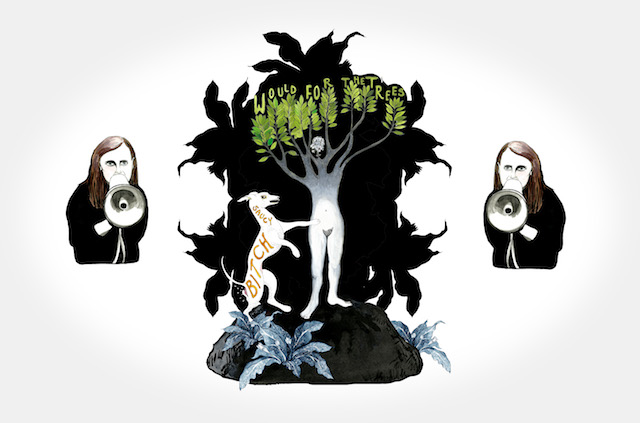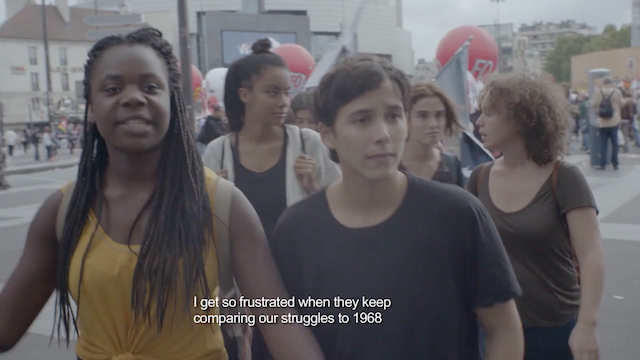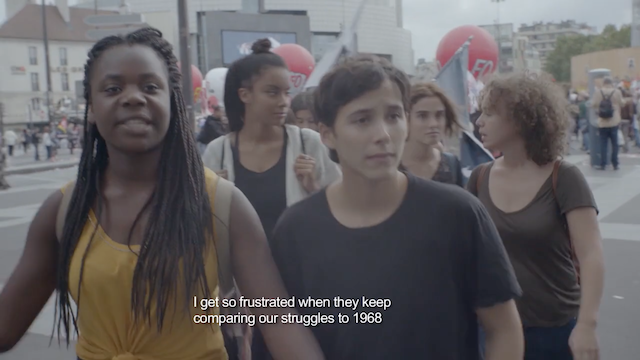The City of Ladies (2017) was filmed on the streets of Paris at the conclusion of the Nuit debout protests against proposed labour reform in June 2016, less than a year after coordinated terrorist attacks across the city left 130 people dead. A collaboration between the Sydney-based artist Zanny Begg and her childhood friend, Paris-based filmmaker Elise McLeod, the 20-minute-long video installation responds to cues from two different – but related – cultural and historical moments.
The first is contemporary Paris and the new forms of collective action that have emerged to challenge the city’s takeover by heavy-handed police in the aftermath of the attacks. This social movement, which aligns itself with alterglobalisation activists around the world, is filtered for the purposes of the video through the perspectives of seven young women. Through a nonlinear series of vignettes combining documentary footage with scripted dramatic passages, Begg and McLeod explore the experiences of these young female activists, many from migrant backgrounds, as they move around the city. Scenes of the women protesting, dancing, gossiping and philosophising, during nightly assemblies at the Place de la République or over lazy cigarettes on the banks of the Seine, reveal their nascent feminism converging with other social-justice struggles of the time, expressed in conversations among themselves and encounters with other groups.
Much of the work’s dialogue came out of a workshop in which the women – respondents to an advertisement placed by Begg and McLeod on casting sites – shared stories about their experiences as politically engaged Parisiennes in the twenty-first century. Their political awareness is also visibly shaped by filmed exchanges with critical thinkers including Hélène Cixous, Silvia Federici, Fatima-Ezzahra Benomar and Sharone Omankoy. Woven into The City of Ladies, excerpts from these conversations introduce an intergenerational and pedagogical dimension to the film’s discussions of contemporary feminism.

The film takes its second cue from a very different milieu to the gritty urbanism of present-day Paris: a 600-year-old imaginary city, built, occupied and governed exclusively by women. Written by Christine de Pizan in 1405, The Book of the City of Ladies conjures a walled utopia populated by real and allegorical women, whose contributions to history its author enumerates. Begg refers to the book as ‘a catalogue of amazing women’ in an interview produced by the Museum of Contemporary Art Australia, which premiered The City of Ladies (2016) in the 2017 edition of its biennial The National: New Australian Art. Despite her prolific and iconoclastic output – de Pizan wrote 41 books in a 30-year career and deployed a range of innovative rhetorical techniques to challenge the misogynistic leanings of her male contemporaries – it is only in recent decades that writers such as Simone de Beauvoir have acknowledged de Pizan’s impassioned defence of women as a protofeminist treatise.
It plays over scenes of the teenage girls engaged in acts of political and sexual liberation, or caught unaware in moments of self-actualisation. Developing confidence in their own voices, they join in the provocative chorus
Begg and McLeod take inspiration from this pioneering text, recognising in it a centuries-old antecedent to the present moment, in which the legitimacy of the white male viewpoint is in crisis. Loosely following the dialogic structure of de Pizan’s book, The City of Ladies also revolves around a group of women imagining a feminist utopia – a perspective on the world that de Pizan called feminania – absent of the discrimination and disempowerment that permeates their lives. Refocusing de Pizan’s lens of misogyny on the present, the filmmakers connect current feminist debates around reproductive rights, the legislation of women’s bodies, rape culture and domestic violence to the mistreatment of women condemned by the late medieval author, which escalated, not long after the book’s publication, into the witch trials of the fifteenth and sixteenth centuries. “The witch hunt was the equivalent of the war on terror today in its criminalisation of a broad range of behaviours,” explains Silvia Federici at one point, tracing a lineage from the persecution of Joan of Arc to the recent burkini ban in France.
In drawing these parallels, The City of Ladies also acknowledges the important contribution made by intersectional feminism to the debate in recent years. The idea that discrimination rarely occurs in isolation, and that its injury is amplified by the cumulative manner in which different forms of discrimination can overlap and intersect, finds voice in the film’s young leads, many of whom are of different ethnicities and are contending with religious, racial or sexual prejudice simultaneously. Issues of immigration, terrorism, postcolonialism, transgenderism, Afro-feminism, labour, teenage pregnancy and Islamophobia are refracted through the lens of misogyny in the film and threaded through the women’s individual narratives. As one of the young women declaims during a march protesting proposed labour reforms: “We’re fighting for workers’ rights, so let’s actually see women’s labour in this struggle”.

In dramatising the manifold experiences of this group of young activists, Begg and McLeod (like de Pizan before them) subvert the idea of a single, teleological narrative, instead representing multiple intersecting feminist histories and experiences, whose relationship to other facets of identity politics is also portrayed. “Feminisms, not feminism,” as Begg explains, “the only way feminism can exist is by having space for difference.” The video’s labyrinthine structure reinforces this logic. An algorithm devised by programmer Andrew Nicholson edits the work, determining which of these heterogeneous stories a viewer encounters at any particular moment. Adapting the language of video gaming, the algorithm randomises the selection and compilation of 52 different narrative strands into a nonlinear, single-channel video framed every 20 minutes by predetermined title and end sequences, looping endlessly. There are roughly 300,000 iterations that can be animated by this algorithm, its chance decisions laying different emphases on the video’s themes.
In ceding control over the final edit, Begg and McLeod have created a work that exposes the bias of traditional historiographies – masculinist, colonial, Western – instead foregrounding multiple neglected stories and viewpoints. “If you think history is on your side, let me remind you that women didn’t write these books – if they had, the stories would be different,” voices one of the protagonists over slow-motion shots of the women dancing uninhibitedly against a backdrop, designed by Begg, featuring illustrations of women in domestic servitude. At the same time, the film’s revisionist feminist impulse is particularly strong in the concluding sequence, which, with its rousing and triumphant tone, suggests precisely that teleological arc that the filmmakers are seeking to disrupt.

In the film’s opening and concluding sequences, a refrain from the Eagles of Death Metal song Kiss the Devil (2004) – which was playing as the terrorists opened fire in the Bataclan – erupts, its unhinged guitar riffs acting as sonic ballast to the film’s intellectualism
The complexities of revisionism take shape around specific musical cues in the film, many of which repeat or recur as variations on a theme in concert with the algorithmic editing process. At times, the women’s rendition of the childhood song ‘Who were the witches?’ is delivered with the playfulness of a schoolyard ditty; at other times, the song’s association of women with witchcraft is imbued with a formidable sense of feminist reclamation. In the film’s opening and concluding sequences, a refrain from the Eagles of Death Metal song Kiss the Devil (2004) – which was playing as the terrorists opened fire in the Bataclan – erupts, its unhinged guitar riffs acting as sonic ballast to the film’s intellectualism. Covered by the Australian postpunk feminist band Mere Women (in another act of reclamation), it plays over scenes of the teenage girls engaged in acts of political and sexual liberation, or caught unaware in moments of self-actualisation. Developing confidence in their own voices, they join in the provocative chorus: “I’ll kiss the devil, I’ll sing his song.”
The conceptual and affective power of The City of Ladies lies in its examination of the performance of resistance – a choreography of gestures at times fierce, at times vulnerable and uncertain – within the young women’s public and private spheres. Slipping between documentary and dramatic modes to look at the urgencies of feminism in the contemporary climate, it explores how we gather ourselves to enact the futures we imagine.

